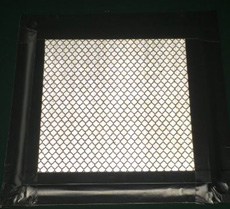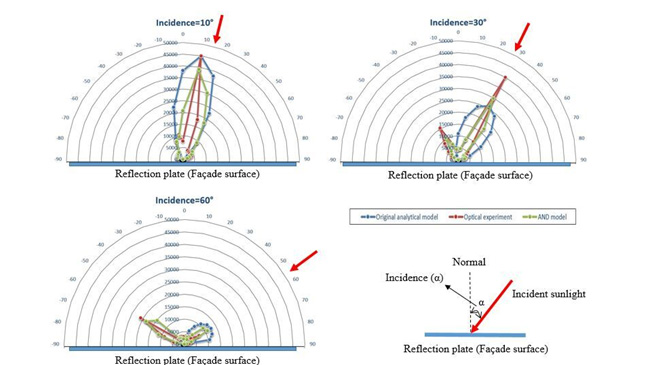
ここからコンテンツです。

Advanced facade material for urban heat island mitigation
Evaluate the reflection directional performance of the retro-reflective materials by new analytical models By Jihui Yuan
A joint research team led by Assistant Professor Jihui Yuan at the Department of Architecture and Civil Engineering of Toyohashi University of Technology, in collaboration with Osaka City University, has proposed two analytical models to evaluate the reflection directional characteristics of retro-reflective (RR) materials applied to building envelopes for urban heat island (UHI) mitigation. Based on the measured data of optical experiments, it was shown that the predication result of the anisotropic body of rotation of the normal distribution (AND) function model is more accurate than that of the original analytical model.
Currently, countermeasures for UHI mitigation have been implemented widely. It has also been reported that the solar reflectivities of a building’s exterior wall surface and pavement act as important indexes affecting the air-conditioning requirements for buildings in terms of energy use. Rooftops covered with diffuse highly reflective (DHR) materials (i.e., highly reflective paints) can reflect solar radiation to the sky so long as there are no higher buildings around. However, if there are taller buildings nearby, much of this radiation ends up being reflected onto neighboring buildings and roads. This heat is absorbed by the neighboring buildings and roads, thus aggravating the UHI phenomenon. To solve this problem in applying DHR materials to building facades, RR materials have been recommended to replace DHR materials to mitigate the UHI phenomenon and reduce the energy consumption of buildings.

However, RR materials are still in the research stage and have not yet been used in practice. Before RR materials can be applied to building envelopes in practice, more theoretical work urgently needs to be done to predict the reflection directional characteristics of RR materials. Up to now, optical experiments have been the main method adopted to evaluate the reflection directional characteristics of RR materials, but it has proved difficult to achieve accurate model predictions.
Thus, a joint research team led by Assistant Professor Jihui Yuan at the Dept. of Architecture and Civil Engineering of Toyohashi University of Technology, in collaboration with Osaka City University, has proposed two analytical models to potentially evaluate the reflection directional characteristics of three RR samples determined by their research team, then comparing the prediction results of the two analytical models to that of the optical experiment in the research. The results of this research were published in the Elsevier journal "Energy & Buildings" on September 15, 2020.
This research mainly consists of three parts; the first is the production of RR samples, the second is the optical measurement of RR samples, and the third is the proposal of analytical models based on optical measurement data.
In this study, two analytical models were introduced to evaluate the reflection directional characteristics of RR materials. To propose an appropriate model to evaluate the reflection directional characteristics of RR materials, the angular distribution of reflection intensity evaluated by two analytical models for three types of RR plates were compared. It was shown that applying the AND model to evaluate the angular distribution of reflection intensity for RR materials achieved more favorable results than in the original analytical model.

Future work should endeavor to improve the evaluation accuracy of analytical models, focusing on proposing other models to possibly evaluate the reflection directional characteristics of RR materials, such as using the artificial neural network (ANN) methodology. Moreover, forthcoming work will also aim to develop three-dimensional optical systems to continue this research, by proposing a three-dimensional model for evaluating the three-dimensional reflective directional performance of RR materials.
This study was supported by Osaka City University and the UNITIKA Corporation of Japan. The author is sincerely grateful to the UNITIKA Corporation of Japan for providing the glass beads used to create the RR samples, and Osaka City University for providing the optical apparatus.
Reference
Jihui Yuan, Kazuo Emura, and Craig Farnham (2020). Analytical model to evaluate the reflective directional characteristics of retro-reflective materials. Energy and Buildings, Vol. 223, 110169.
DOI: 10.1016/j.enbuild.2020.110169
都市ヒートアイランド緩和のための高度なファサード素材
分析モデルを使用して、建物のファサードに適用される再帰反射材料の反射方向性能を評価By 袁 継輝
豊橋技術科学大学 建築・都市システム学系の袁 継輝(えん けいき)助教率いる共同研究チームは、大阪市立大学との共同で、光学実験の測定データに基づいて、都市ヒートアイランド(UHI)緩和のための建物外皮に適用される再帰反射(RR)材料の反射方向特性を評価するための二つの分析モデルを提案しました。正規分布関数(AND)モデルの異方性回転体の予測結果は、元の分析モデルの予測結果よりも正確であることが示されました。
現在、UHI緩和策が広く実施されています。また、建物の外壁面と舗装の太陽光反射率は、エネルギー使用に直接関係する建物の空調熱負荷に影響を与える重要な指標であると報告されています。拡散型高反射(DHR)材料(例えば、高反射率塗料)で覆われた屋根は、周囲に高層ビルがない場合、太陽放射を天空に反射する可能性があります。ただし、近くに高層ビルがあると、近隣のビルや道路に多くの太陽放射が反射する可能性があります。その結果、太陽放射は近隣の建物や道路に吸収され、UHI現象を悪化させます。建物のファサードにDHR材料を適用する際のこの問題を解決するために、DHR材料の代わりにRR材料を使用してUHI現象を軽減し、建物のエネルギー消費を削減することが推奨されています。
ただし、RR材料はまだ研究段階にあり、実際には使用されていません。RR材料を建物外皮に適用する前に、RR材料の反射方向特性を予測することが最も緊急の課題の一つになっています。予測手法については、主にRR材料の反射方向特性を評価するために光学実験が採用されています。ただし、正確なモデル予測手法はほとんどありません。
そのため、豊橋技術科学大学 建築・都市システム学系の袁 継輝(えん けいき)助教率いる共同研究チームは、大阪市立大学との共同で、研究チームが試作した三つのRRサンプルの反射方向特性の評価を可能にするための二つの分析モデルを提案し、二つの分析モデルの予測結果を研究における光学実験の予測結果と比較しました。本研究の成果は、2020年9月15日にエルゼビアの学術誌「Energy & Buildings」に掲載されました。
本研究は主に三つの部分から構成されています。一つ目はRRサンプルの作成、二つ目はRRサンプルの光学測定、三つ目は光学測定データに基づく分析モデルの提案です。
本研究では、RR材料の反射方向特性を評価するために二つの分析モデルが導入されています。RR材料の反射方向特性を評価するための適切なモデルを提案するために、三種類のRRプレートの二つの分析モデルによって評価された反射強度の角度分布を比較しました。ANDモデルを適用してRR材料の反射強度の角度分布を評価すると、元の分析モデルと比較してより好ましい結果が得られることが示されました。
今後の研究では、人工ニューラルネットワーク(ANN)手法の使用など、RR材料の反射方向特性の評価を可能にする他のモデルの提案に焦点を当て、分析モデルの評価精度の向上に努める必要があります。さらに、RR材料の三次元反射指向性能を評価するための三次元モデルを提案するために、今後の研究では、本研究を継続するための三次元光学システムの開発も目指します。
Researcher Profile

| Name | Jihui Yuan |
|---|---|
| Affiliation | Department of Agriculture and Civil Engineering |
| Title | Assistant Professor |
| Fields of Research | Building and Environment Engineering |
ここでコンテンツ終わりです。
